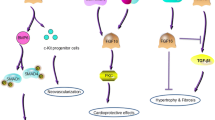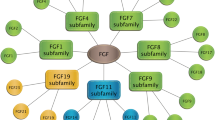Abstract
Fibroblast growth factor receptors (FGFRs) undergo highly regulated spatial and temporal changes of expression during development. This study describes the use of quantitative reverse transcriptase-polymerase chain reaction and immunochemistry to assess the changes in expression of FGFR4 as compared to its FGFR4-17a and -17b isoforms in mouse tissues, from early embryogenesis through to adulthood. Compared to FGFR4, the expression of the isoforms is more restricted at all developmental stages tested. The reverse transcriptase-polymerase chain reaction demonstrated that FGFR4 is expressed in more tissue types than either of its isoforms: it was found predominantly in lung, liver, brain, skeletal muscle and kidney, whereas the FGFR4-17a form was detected in lung and skeletal muscle, and the FGFR4-17b form only in lung, liver, skeletal muscle and kidney. Immunohistochemistry confirmed strong FGFR4-17b expression in the postnatal lung. When combined, the results suggest that FGFR4 variants play important roles particularly in lung and skeletal muscle development.
Similar content being viewed by others
References
Abbass SA, Asa SL, Ezzat S (1997) Altered expression of fibroblast growth factor receptors in human pituitary adenomas. J Clin Endocrinol Metab 82: 1160–1166.
Burgess AW (1998) Growth control mechanisms in normal and transformed intestinal cells. Philos Trans R Soc Lond B Biol Sci 353: 903–909.
Cool SM, Jackson R, Dickinson I, Pincus P, Nurcombe V (2002) Fibroblast growth factor receptor 4 (FGFR4) expression in newborn murine calvaria and primary osteoblast cultures. Int J Dev Biol 46: 519–523.
deLapeyriere O, Ollendorff V, Planche J, Ott MO, Pizette S, Coulier F, Birnbaum D (1993) Expression of the Fgf6 gene is restricted to developing skeletal muscle in the mouse embryo. Development 118: 601–611.
Dickson C, Spencer-Dene B, Fantl V (2000) Tyrosine kinase signaling in breast cancer: Fibroblast growth factors and their receptors. Breast Cancer Res 2(3): 191–195.
Eisemann A, Ahn JA, Graziani G, Tronick SR, Ron D (1991) Alternative splicing generates at least five different isoforms of the human basic - FGF receptor (published erratum appears in Oncogene 1991 6(12): 2379). Oncogene 6: 1195–1202.
Frank O, Heim M, Jakob M, Barbero A, Schafer D, Bendik I, Dick W, Heberer M, Martin I (2002) Real-time quantitative RT-PCR analysis of human bone marrow stromal cells during osteogenic differentiation in vitro. J Cell Biochem 85: 737–746.
Fujiwara M (1997) Proliferation and differentiation of olfactory cells in primary culture system. Nippon Jibiinkoka Gakkai Kaiho 100: 332–341.
Galzie Z, Kinsella AR, Smith JA (1997) Fibroblast growth factors and their receptors. Biochem Cell Biol 75: 669–685.
Jaakkola S, Salmikangas P, Nylund S, Partanen J, Armstrong E, Pyrhonen S, Lehtovirta P, Nevanlinna H (1993) Amplification of fgfr4 gene in human breast and gynecological cancers. Int J Cancer 54: 378–382.
Johnson DE, Lu J, Chen H, Werner S, Williams LT (1991) The human fibroblast growth factor receptor genes: A common structural arrangement underlies the mechanisms for generating receptor forms that differ in their third immunoglobulin domain. Mol Cell Biol 11: 4627–4634.
Johnson DE, Williams LT (1993) Structural and functional diversity in the FGF receptor multigene family. Adv Cancer Res 60: 1–41.
Kastner S, Elias MC, Rivera AJ, Yablonka-Reuveni Z (2000) Gene expression patterns of the fibroblast growth factors and their receptors during myogenesis of rat satellite cells. J Histochem Cytochem 48: 1079–1096.
Kostrzewa M, Muller U (1998) Genomic structure and complete sequence of the human FGFR4 gene. Mamm Genome 9: 131–135.
Martin GR (1998) The roles of FGFs in the early development of vertebrate limbs. Genes Dev 12: 1571–1586.
Olson DC, Deng C, Hanahan D (1998) Fibroblast growth factor receptor 4, implicated in progression of islet cell carcinogenesis by its expression profile, does not contribute functionally. Cell Growth Differ 9: 557–564.
Partanen J, Makela TP, Eerola E, Korhonen J, Hirvonen H, Claesson-Welsh L, Alitalo K (1991) FGFR-4, a novel acidic fibroblast growth factor receptor with a distinct expression pattern. Embo J 10: 1347–1354.
Pazin MJ, Williams LT (1992) Triggering signaling cascades by receptor tyrosine kinases. Trends Biochem Sci 17: 374–378.
Penault-Llorca F, Bertucci F, Adelaide J, Parc P, Coulier F, Jacquemier J, Birnbaum D, deLapeyriere O (1995) Expression of FGF and FGF receptor genes in human breast cancer. Int J Cancer 61: 170–176.
Sashihara S, Tsuji S, Matsui T (1998) Oncogenes and signal transduction pathways involved in the regulation of Na+ channel expression. Crit Rev Oncog 9: 19–34.
Stark KL, McMahon JA, McMahon AP (1991) FGFR-4, a newmember of the fibroblast growth factor receptor family, expressed in the definitive endoderm and skeletal muscle lineages of the mouse. Development 113: 641–651.
Szebenyi G, Fallon JF (1999) Fibroblast growth factors as multifunctional signaling factors. Int Rev Cytol 185: 45–106.
Uruno T, Komi A, Imamura T (1998) Progress of signal transduction research for fibroblast growth factors. Seikagaku 70: 446–453.
Vainikka S, Partanen J, Bellosta P, Coulier F, Birnbaum D, Basilico C, Jaye M, Alitalo K (1992) Fibroblast growth factor receptor-4 shows novel features in genomic structure, ligand binding and signal transduction. Embo J 11: 4273–4280.
van Heumen WR, Claxton C, Pickles JO (1999) Fibroblast growth factor receptor-4 splice variants cause deletion of a critical tyrosine. IUBMB Life 48: 73–78.
Weinstein M, Xu X, Ohyama K, Deng CX (1998) FGFR-3 and FGFR-4 function cooperatively to direct alveogenesis in the murine lung. Development 125: 3615–3623.
Xie MH, Holcomb I, Deuel B, Dowd P, Huang A, Vagts A, Foster J, Liang J, Brush J, Gu Q, Hillan K, Goddard A, Gurney AL (1999) FGF-19, a novel fibroblast growth factor with unique specificity for FGFR4. Cytokine 11: 729–735.
Yu C, Wang F, Kan M, Jin C, Jones RB, Weinstein M, Deng CX, McKeehan WL (2000) Elevated cholesterol metabolism and bile acid synthesis in mice lacking membrane tyrosine kinase receptor FGFR4. J Biol Chem 275: 15482–15489.
Author information
Authors and Affiliations
Rights and permissions
About this article
Cite this article
Cool, S.M., Sayer, R.E., van Heumen, W.R. et al. Temporal and Spatial Expression of Fibroblast Growth Factor Receptor 4 Isoforms in Murine Tissues. Histochem J 34, 291–297 (2002). https://doi.org/10.1023/A:1023326524562
Issue Date:
DOI: https://doi.org/10.1023/A:1023326524562




